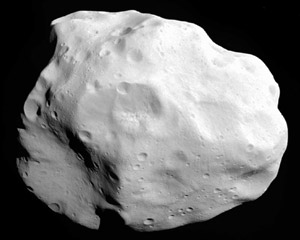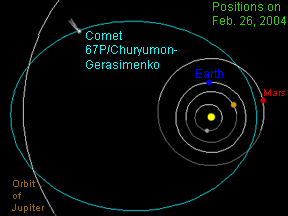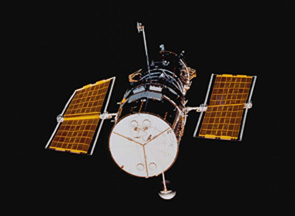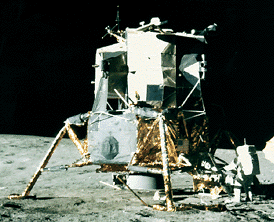Asteroid Lutetia as viewed by the Rosetta spacecraft on July 10, 2010.
Click on image for full size
Image courtesy of ESA 2010 MPS for OSIRIS Team MPS/UPD/LAM/IAA/RSSD/INTA/UPM/DASP/IDA.
Rosetta Flyby of Asteroid Lutetia
Rosetta is a European space probe. It was launched in 2004. Its main mission is to fly to a comet and land on it. Along the way it has flown by two asteroids. In July 2010 it flew by an asteroid named Lutetia.
Lutetia is the largest asteroid visited by a spacecraft so far. The average diameter of Lutetia is 96 km (60 miles). Lutetia isn't round like a planet. It is quite lumpy. Rosetta beamed some great pictures of Lutetia back to Earth.
Rosetta was zooming along at a speed of 15 km/s (9 miles/sec or more than 33,000 mph) when it passed Lutetia! It flew within 3,160 km (1,964 miles) of the asteroid. In 2008 Rosetta flew by another asteroid named Steins. Rosetta is now on its way to Comet Churyumov-Gerasimenko. It won't get there until 2014! If everything works out, Rosetta will be the first spacecraft to land on a comet.
You might also be interested in:

Lutetia is a medium-sized asteroid. It orbits the Sun in the main asteroid belt between the planets Mars and Jupiter. Its official name is "21 Lutetia" because it was the 21st asteroid discovered. Lutetia
...more
Comet 67P/Churyumov-Gerasimenko was discovered in 1969 by Klim Churyumov and Svetlana Gerasimenko. The comet orbits the Sun once every 6.57 years. Its orbit brings it closer to the Sun than Mars at the
...more
Rosetta is a European space probe. It was launched in 2004. Its main mission is to fly to a comet and land on it. Along the way it has flown by two asteroids. In July 2010 it flew by an asteroid named
...more
The Hubble Space Telescope (HST) was one of the most important exploration tools of the past two decades, and will continue to serve as a great resource well into the new millennium. The HST found numerous
...more
Driven by a recent surge in space research, the Apollo program hoped to add to the accomplishments of the Lunar Orbiter and Surveyor missions of the late 1960's. Apollo 11 was the name of the first mission
...more
Apollo 12 was launched on Nov. 14, 1969, surviving a lightning strike which temporarily shut down many systems, and arrived at the Moon three days later. Astronauts Charles Conrad and Alan Bean descended
...more
Apollo 15 marked the start of a new series of missions from the Apollo space program, each capable of exploring more lunar terrain than ever before. Launched on July 26, 1971, Apollo 15 reached the Moon
...more














